

James IV of Scotland. James IV (17 March 1473 – 9 September 1513) was King of Scots from 11 June 1488 to his death.
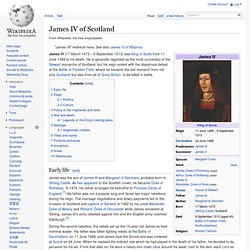
He is generally regarded as the most successful of the Stewart monarchs of Scotland, but his reign ended with the disastrous defeat at the Battle of Flodden Field, where he became the last monarch from not only Scotland, but also from all of Great Britain, to be killed in battle. Early life[edit] During the second rebellion, the rebels set up the 15-year-old James as their nominal leader. His father was killed fighting rebels at the Battle of Sauchieburn on 11 June 1488, and James took the throne and was crowned at Scone on 24 June. When he realised the indirect role which he had played in the death of his father, he decided to do penance for his sin. Reign[edit] Politics[edit] Culture[edit] James IV was a true Renaissance prince with an interest in practical and scientific matters.
James was well educated and a fluent polyglot. The King is 25 years and some months old. War and death[edit] James IV Feature Page on Undiscovered Scotland. James IV one of the greatest Scottish kings. In June 1488 at the Battle of Sauchieburn King James III of Scotland was defeated and killed.
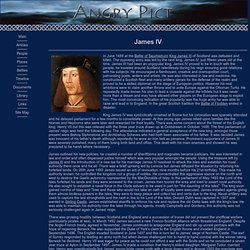
The opposing army was led by the next king, James IV, just fifteen years old at the time. James III had been an unpopular king. James IV proved to be in touch with the people, he traveled around Scotland relentlessly during his reign ensuring good relations with his subjects. He encouraged a flamboyant, creative and cosmopolitan court, patronising poets, writers and artists.
He was also interested in law and medicine. King James IV was symbolically crowned at Scone but his coronation was sparsely attended and he delayed parliament for a few months to consolidate power. James outlined his new policies, he created a number of sheriffdoms and magnates became justiciars. There was growing hostility between Scotland and England and a succession of truces did not prevent the unofficial warfare (particularly pirates at sea). After 1509 James IV held no more parliaments. Renaissance Scotland - James IV - Renaissance, Reformation and Mary Queen of Scots - Scotlands History. James took the throne on 11 June 1488.
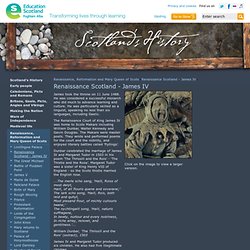
He was considered a successful monarch who did much to advance learning and culture. He was particularly skilled as a linguist, speaking no less than six languages, including Gaelic. The Renaissance Court of King James IV was home to Scots Makars including William Dunbar, Walter Kennedy and Gavin Douglas. The Makars were master poets. They wrote and performed poems for the court and the nobility, and enjoyed literary battles called ‘flytings’. King James IV. King James III had a turbulent reign and in 1482, an English army, supporting the cause of James' brother, Alexander, Duke of Albany, invaded Scotland.
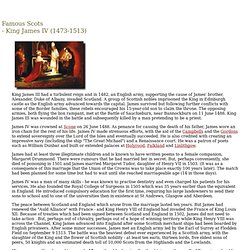
A group of Scottish nobles imprisoned the King in Edinburgh castle as the English army advanced towards the capital. James survived but following further conflicts with some of the Border families, these rebels encouraged his 15-year-old son to claim the throne. The Freelance History Writer. King James IV of Scotland After all the turmoil of James III’s time in power as King of Scotland, his son’s reign seems positively peaceful.

James IV ushered the Renaissance into Scotland in many ways. He cemented an alliance with England, patronized the arts, and built wonderful palaces and a strong navy. King James IV. James IV (1473 - 1513, king from 1488) James Stuart was the son of James III and Margaret of Denmark.

He owed his throne to a noble coup (which was partly animated by hatred of the English) which led to the death of his father at the battle of Sauchieburn (after which James wore around his waist 'ane belt of irone' in expiation). James removed the dominant barons and substituted wise counsel to consolidate his realm. During the early years of his reign intellectual study was nourished, for in 1495 King's College, Aberdeen, was founded, and in 1505 a College of Surgeons was established in Edinburgh, and the College of St Leonard was set up in St Andrews and the first royal residence was built at Holyrood.
There was an improvement in relations with England, though it was Henry VII who set the pace. Henry had to endure Scottish patronage of Perkin Warbeck, but after 1498 he was determined to obtain a permanent peace with James. Back to. James IV of Scotland (DNB00) After his coronation James came on 26 June from Perth to Stirling, attended his father's obsequies at Cambuskenneth, and after presiding over the audit of exchequer on 7 July, went to Edinburgh.
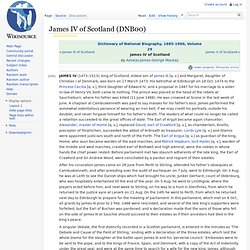
On 3 Aug. he was at Leith to see the Danish ships which had brought his uncle, Junker Gerhard, count of Oldenburg, who was hospitably entertained till the end of the year. On 5 Aug. he went to Linlithgow, where the players acted before him, and next week to Stirling, on his way to a hunt in Glenfinlas, from which he returned to the justice ayre at Lanark on 21 Aug. On the 14th he went to Perth, from which he returned next day to Edinburgh to prepare for the meeting of parliament. On 28 July 1500 Henry obtained a papal dispensation for James's marriage with Margaret.
Kings and Queens of Scotland - James IV. James IV, one of the best loved of Scotland's Monarchs, was an endearing but idealistic character, who inspired great loyalty from his subjects.
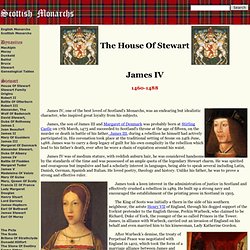
James, the son of James III and Margaret of Denmark was probably born at Stirling Castle on 17th March, 1473 and succeeded to Scotland's throne at the age of fifteen, on the murder or death in battle of his father, James III, during a rebellion he himself had actively participated in. His coronation took place at the traditional setting of Scone on 24th June, 1488. James was to carry a deep legacy of guilt for his own complicity in the rebellion which lead to his father's death, ever after he wore a chain of expiation around his waist. Overview of King James IV. The life of King James IV : Scotland Magazine Issue 31.
This issue, James Irvine Robertson looks at the history of James IV, the man responsible for the creation of the Kingdom of Scotland When one considers Scottish institutions, the Conservative Party does not immediately spring to mind.

Today it fields but a single minister of parliament from a Scots constituency in the House of Commons, although as recently as 1955 it, uniquely, managed to obtain more than half the Scottish votes at a General Election, and 36 of the 71 seats. In December 2006, the United Kingdom Conservative Party published a list of a dozen people ‘who played a lead role in creating the institutions that have shaped our country’s history.’ Saint Columba, arguably an Irishman, is one. He is credited with ‘Christianity in Britain’ although some might say that his was a Celtic and Highland mission that lost out to the Roman Catholicism introduced by St Augustine in the south. His recorded bastards number half a dozen, comparatively modest for a Stewart king. King James IV of Scotland (1473-1513) The Kingship of James IV of Scotland - 'The Glory of All Princely Governing'?
Norman Macdougall explores the vicissitudes of James IV's reign; although regarded as a paragon amongst Scottish kings, his downfall owed much to his failings.
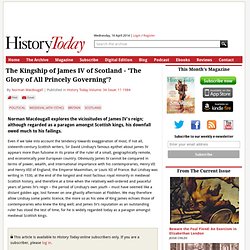
Even if we take into account the tendency towards exaggeration of most, if not all, sixteenth-century Scottish writers, Sir David Lindsay's famous epithet about James IV appears more than fulsome in its praise of the ruler of a small, geographically remote, and economically poor European country. James IV Stewart, King of Scots (1473 - 1513.
James IV Stewart, King of Scots was born on 17 March 1473 at Stirling Castle, Scotland and died on 9 September 1513 at The Battle of Flodden Field, Northumberland, England. His body was lost but his head is buried at St Michael Wood Street, London England. He was also known as Seumas IV Stiùbhairt, James, Duke of Rothesay, Ruled: 11 June 1488 - 9 September 1513 Preceded by: James III 3 August 1460 - 11 June 1488 Succeeded by: James V 11 June 1488-14 December 1542 Coronation: 24 June 1488. Medical and Scientific Exploits of King James IV of Scotland. The Stewarts > James IV. Category:Court of James IV of Scotland. Scotland's History - James IV, King of Scots. James IV (king of Scotland. King James IV of Scotland.
Books & Posters House of Stewart Family Tree Detailed Tree English King or Queen at the Time. Category:Illegitimate children of James IV of Scotland. Category:Mistresses of James IV of Scotland. Margaret Drummond (mistress) Her death has been the subject of a very persistent romantic legend. King James IV of Scotland She was definitely the mistress of James IV during 1496-97, and possibly as early as 1495. Records show her living in his castle at Stirling from 3 June 1496, and from 30 October to March 1497 at Linlithgow Palace. Her presence,and a previous similar arrangement for another mistress in the royal houses, was also noted by the Spanish ambassador Pedro de Ayala.[1] Ayala later wrote of James IV; "When I arrived, he was keeping a lady with great state in a castle. Margaret and James IV had a daughter, Margaret Stewart. It is definitely known that in 1501 she died of food poisoning, along with her sisters Eupheme and Sibylla, while staying at their parents' residence.
It has been widely suggested in more recent years that Margaret Drummond was murdered, either by English agents or by pro-English elements in the Scottish nobility. Serious historians are skeptical of the theory. Marion Boyd (mistress) Marion Boyd (fl. late 15th century), also known as Margot or Margaret, was a mistress of King James IV of Scotland, and his first important mistress.
She was related to Thomas Boyd, Earl of Arran, and a niece of the second wife of Archibald Douglas, 5th Earl of Angus. Her relationship with the king was linked with the rise and fall of Angus's influence at the court. Janet Kennedy. Through her father, she was a great-great-granddaughter of King Robert III. Janet Kennedy's mother, Lady Elizabeth Gordon, was a daughter of Alexander Gordon, 1st Earl of Huntly.
Originally she was married to the formidable Archibald Douglas, 5th Earl of Angus ("Bell the Cat"), they had a daughter, Mary, together. The King had a number of mistresses, but this appears to have been his longest relationship, which continued even after his marriage to Margaret Tudor. After James IV's marriage by proxy, he met Janet at Bothwell Castle in April 1503, then she was sent to Darnaway Castle in August just before Margaret arrived.[1] It is not clear if she is the same as the "Janet bair ars" who received gifts from the king in 1505–12.[2] She also had relationships with two other men.
External links[edit] Jump up ^ Accounts of the Lord High Treasurer of Scotland, vol. 2 (1900), xxxiii, 297Jump up ^ McDougall p 286 Lundy, Darryl (7 May 2008). References[edit] James IV of Scotland. Treaty of Perpetual Peace. The Treaty of Perpetual Peace was signed by James IV of Scotland and Henry VII of England in 1502. It agreed to end the intermittent warfare between Scotland and England which had been waged over the previous two hundred years and although it failed in this respect, as the hostility continued intermittently throughout the 16th century, it led to the Union of the Crowns 101 years later. Exhibitions & Learning online. First Golfer King James IV Perth, Scotland. Details for James IV of Scotland AD 1488 - AD 1513 - A guide to the coins of the Medieval period. Holyrood Palace, James Iv's Tower Palace Of Holyrood; Palace Of HolyroodhouseDetails Details.
Person - James IV of Scotland. James IV, 1473 - 1513. Reigned 1488 - 1513 − Unknown − U − Artists A-Z − Online Collection − Collection.
Flodden.